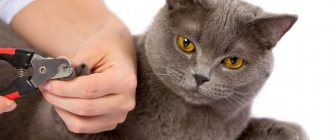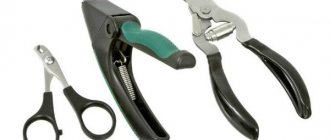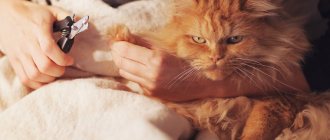Everyone who has a cat knows that animals want not only affection and love, but also care. Perhaps you are just planning to adopt a kitten into your family, or if you have already adopted a little furry one, then you naturally have various questions about caring for a new family member. An important point in caring for an animal is the correct and timely trimming of a cat’s claws.
The article below discusses the topic of nail trimming for kittens and adults. From it you will learn why to do this and with what tools. You will also read whether the breed of the animal is related to claw trimming and much more. Happy reading!
What's special about a cat's claws?
The cat's claws are interesting because they are retractable. Thanks to the unique structure of tendons and ligaments, nails can:
- hide when running or sneaking up on game;
- pull when jumping on prey, climbing, defending itself.
Cats mark trees with their claws to mark their territory. At the same time, they release pheromones that signal their presence to other cats. This way, when the cat is at rest, the claws do not touch the ground and wear down naturally, as in dogs.
Both wild and domestic cats need claws to walk properly. Unlike other animals, when walking they do not rely on their feet, but only on their toes. The heel does not touch the ground.
What to do if damaged?
If, however, damage occurs to the animal while trimming its nails, stop immediately and begin treating the injury or wound. To begin, prepare some cotton pads and anti-bleeding agents so you have everything at hand. If the injury is more serious than you thought, try to stop the bleeding and go to the vet. He will tell you what to do and what to do next.
Once you've finished trimming his nails, treat your friend to his favorite treat.
Advice: do not force the animal to cut its nails and do not mock it while trimming its claws, because this way it will avoid not only this procedure, but possibly you as well.
But if you still do not plan to do the first procedure on your own, carry out this haircut under the supervision of a veterinarian. A certified specialist will tell you how to handle the tool and the animal, and tell you how to avoid injuries. He will also give advice on how to make the procedure less stressful for all participants in the process.
Do I need to trim my cat's claws?
Whether cats can have their claws trimmed depends on the pet’s lifestyle – whether she walks outside or just sits at home. In the first case, nails are needed for protection, hunting, and climbing. She won't survive in the yard without them.
When you have an indoor cat, claws grow quickly and there are no natural mechanisms to wear them down. The animal is forced to grind them off - on furniture, walls, and other objects. There is no point in punishing a cat for this - it is a reflex that cannot be eliminated. To direct your instinct in the right direction, you definitely need to buy a scratching post and don’t forget about cutting the plates.
Why trim cats' claws? As pets age, they lose activity, stop using scratching posts, and damage furniture. The plates still need to be cut off, since they will grow back, bend, and can penetrate into the pad and cause inflammation. Especially often the problem occurs with the fifth, most inconspicuous nail. The only way out in this case is surgical intervention.
Another reason why veterinarians answer yes to the question of whether cats need to have their nails trimmed. This is delamination of the plate, which leads to its breakage. Sometimes the claw can break down to the meat. In this case, the cat will be in great pain and will begin to limp.
Nail trimming and breed
You may be wondering: is there a connection between breed and how often you trim your nails? Veterinarians will tell you that it all depends on the breed of the animal. Therefore, this factor affects how often you trim your pet's nails.
So, according to veterinarians, British dogs should have their nails trimmed every three weeks, as in this breed they grow back quite quickly.
Nail trimming for a Briton
For example, Scottish cats have claws that grow more slowly. In this regard, trimming the claws can be done less frequently. The main thing is to monitor the condition of the nail plate and the pet’s paws in general.
Representatives of the Persian or Sphynx breeds have claws that grow faster than those of other cats. Therefore, monitor nail growth and treat them every two weeks.
The main thing is not to overdo it. It is better to cut less, but more often. If you cut off too much of the nail, you risk injuring the animal. Be careful!
But do not forget that each pet is individual. And therefore, all domestic cats require an individual approach
How can you trim a cat's claws?
Can a cat's nails be trimmed with scissors? To tidy up your paws, buy tools designed not for people, but for cats. They are more convenient to work with and the risk of injury is minimal. In addition, even the sharpest nail scissors are not suitable for cutting animal plates.
To trim a cat's claws at home, you will need:
- Plate shears or sickle or guillotine type nail clippers. Ideally, it should be a tool with stainless steel knives and handle pads that will not allow your hand to slip.
- Cotton wool or gauze in case of bleeding.
- Disinfectant (eg hydrogen peroxide).
- Gloves made of leather or thick fabric that will save your hands from scratches.
- Manicure file.
Nail trimming tools must be sharp. Before the procedure, wipe the knives with a disinfectant to avoid infection if an accidental cut occurs.
Claw clippers
When considering whether to trim your cat's nails, consider nail clippers. Give preference to the guillotine type. It is more convenient to use and cuts plates better. The sickle-shaped tool is intended for animals whose claws are stronger than those of a cat.
What you need to trim nails
To cut cat claws, you need to choose the tool that is most convenient for you, so that it removes excess quickly and painlessly for your pet. You can buy several types of tools to understand exactly which one you intend to use in the future. Since the cat has as many as 18 toes, you can try each type in action.
There are several variations of devices:
- Nail Scissors – The scissors you use to trim your nails should only be used on your teenage kitten's delicate claws. For an adult cat, it is better to have a separate tool, designed taking into account the anatomy of the claw structure.
- Manicure tongs are convenient for removing the tips of claws.
- Blister nail clipper (specialized scissors designed for cats) is an affordable tool that is easy to use.
- Guillon trimmer - this tool can cope with thick claws of the hind paws, the disadvantage of using it is that it is difficult to see which part of the claw will be cut off.
You can choose what is more convenient for you to work with, however, it is preferable to use a blister or guillotine trimmer, because these tools are specially selected for a thick cat's claw.
Additionally, for comfortable nail trimming you may need:
- a piece of cotton wool or a cotton pad;
- hydrogen peroxide;
- hard manicure file;
- a machine for cutting hair (if the cat is too fluffy, this will help remove the hair between the fingers).
At what age should a kitten's nails be trimmed?
Is it possible to trim kittens' nails? Yes, but not for newborns. Small cats do not know how to remove their claws. They are constantly released and spread out. They use marigolds from the first days of life, massaging their mother's nipple with their paws to stimulate milk synthesis. At first the claws are soft and short, then they begin to harden and by 6-8 weeks they leave the first scratches.
When can you trim a kitten's nails? Not earlier than 3 months. The plates harden completely by 6 months. By this time, the kitten can already be accustomed to the procedure.
Make friends with paw
Some cats don't even like having their paws touched, let alone having their claws trimmed. Take the time to make them feel comfortable touching their paws and your efforts will pay off in the long run.
Gently pinch one paw between your fingers and rub gently for two to three seconds. If your cat moves during the process, watch her gesture carefully.
Then squeeze your paw so that one nail extends. Release immediately and give the cat a treat. If you can, do this two or three times a day until your cat gets used to it and doesn't resist as much.
How to trim a kitten's claws correctly
The sooner you start accustoming your cat to trimming its claws, the fewer problems will arise during the procedure. It is important that the first manipulation goes smoothly, without pain or discomfort, otherwise the cat will resist in the future.
How to trim a kitten's claws at home: precautions
Before you start cutting the plates, you need to find out how a kitten’s nail works. It consists of 2 parts - keratinized and living (pulp), where nerves and blood vessels are located. The pulp looks like a dark or pink formation. If you touch it while cutting the plates, the cat will be in pain, will bleed, and will not voluntarily agree to a repeat procedure. Therefore, cutting nails must be approached carefully and carefully.
Step 1. Prepare the kitten mentally
Claw trimming needs to be taught carefully. Both you and the kitten should be calm during the procedure. It is advisable for the pet to be relaxed and even sleepy (for example, after eating). Take other animals from the room - cats, dogs, birds. To prevent your cat from reacting to pigeons, close the curtain.
Step 2. How to trim a cat's claws: train the paw to be petted
Sit on a chair in a quiet, quiet room with the kitten on your lap. Start stroking him, paying attention to his paws. Gently touch each pad. Do not squeeze or pinch the paw. The pet should get used to the fact that you often caress its legs. You can also stroke it behind the ears and in other places where the cat likes it.
Apply gentle pressure to the pad so that the nail comes out. Then lower your paw and give your baby a treat. After some time (preferably the next day), repeat this with the other finger. Do this until you have worked on all the claws.
Step 3. Trimming claws: introduce your pet to the tool
The cat should respond calmly to the clicking sounds of the scissors. Periodically hold the tool in your hand and click close to it. Do this until the cat stops reacting to it.
Step 4. How to trim a cat’s claws yourself: step-by-step instructions
- Place your pet on your lap. Take the paw with one hand and the nail clipper with the other.
- Start massaging the paws, pressing on the pad to stretch the claws.
- Select one finger and carefully examine it to determine where the pulp ends.
- Where to trim cats claws? You only need to cut off the white part of the plate, no less than 2 mm from the pulp. If you are cutting for the first time, you can increase the distance even more and cut it off a little.
- How to trim a cat's claws with a nail clipper? Hold the pliers perpendicular to the plate. If they are placed parallel, the nail may separate.
- To smooth the tip, you can use a nail file.
- As soon as you trim 1 claw, reward your cat with a treat.
- Never cut more than 2 plates at one time - it will be uncomfortable for the cat.
- At first, treat not two, but 1 paw.
- If you accidentally injure your pet, use a cotton swab to stop the bleeding.
When can you start cutting your newborn's nails for the first time?
One of the first questions that a young mother has when caring for her baby is how long after birth can she cut her newborn’s nails?
?
As soon as the baby is born, the edges of his nail plates do not separate from the skin, as they are quite soft. This is why you should not cut a newborn’s nails in the first two weeks - to avoid skin damage and, as a result, a possible inflammatory process. To prevent the child from scratching himself during this period, it is recommended to wear special mittens.
A month after birth, you can safely start cutting your baby’s nails.
How to trim a cat's claws if she's struggling
Do cats need to have their nails trimmed if they don't like the procedure? Before trimming an aggressive cat's nails, swaddle her in a towel. And only then treat your nails. This will protect both you and the animal from injury. Do not shout or punish your pet - this will make the situation worse. Speak in a soothing, gentle voice.
You can also contact a specialist, but keep in mind that with him she will resist more. There is a high probability that he will not be able to calm your pet and trim the plates efficiently.
How to prepare a cat for the first procedure?
You should not trim the claws if your dog is too active and excited, as he may mistake it for violent actions, which will scare him away more. Therefore, choose a time when the kitten is calm, or better yet, when he is very tired. This way he won’t try to escape and won’t get too stressed. Remember the following rule: do not make slow movements when trimming nails, as this may begin to irritate the animal. It will begin to get nervous and break out of the owner’s hands, which will subsequently lead to damage or even injury.
Pet your pet, give him his favorite delicacy. By appeasing your pet, it will be easier for him to make contact with you, and he will be less aggressive before starting the procedure.
And most importantly, you need to talk to the animal. After all, he is also a living creature and loves when the owner speaks to him kindly.
Advice! Remember, the calmer the owner, the more obedient the animal.
So prepare yourself in advance, calm down and tune in, because an animal, even a small one, understands the feelings of its owner.
If the animal still breaks out and becomes nervous, do not yell at it. This will make him even more nervous, which will frighten the animal in the future during the next haircut.
You might think your friend is in pain during the procedure. But if you do everything correctly and at the same time without sudden or too slow movements, then your pet will be satisfied.
Where is the best place to trim a cat's claws?
If you are afraid of injuring the kitten, cutting off the plate incorrectly, you can trim the cat’s claws at a veterinary clinic or at a groomer. It is better for a specialist to come to your home, especially if you do not have vaccinations. In a familiar environment, the animal will feel calmer and less distracted.
If the specialist only works in the clinic, buy a carrier to take the cat there. Otherwise, the animal may escape along the way.
In order not to constantly call a specialist, ask him to show you how to properly cut the plates. The first few times, do the procedure under his supervision. Then handle it yourself.
Introduce your cat to clippers
Unfamiliar objects can cause stress in a cat. Leave the nail clippers out for your cat to explore. You can even leave treats on them for your cat to sniff and become familiar with.
Some cats are afraid of the sound made by nail clippers. Place the cat on your lap and take the clippers. Bring the clippers to the paws and gently massage one paw, touch the paw with the clippers without cutting anything. Immediately reward your cat for taking it all in stride.
Useful tips
- Never trim the plates if the cat is agitated or upset.
- Take your time during the procedure. One awkward movement can lead to injury, injury, or frighten the animal.
- Do not try to treat 2 paws at once, especially when you are just accustoming your pet to the procedure.
- Don't forget about the claw on the 5th finger. If it grows into the skin, it will be very painful for your pet.
- Don’t forget to praise the cat after trimming each claw and give a treat at the end of the procedure.
- Should a cat's back claws be trimmed? Yes, but not as often as the front ones. The back plates grow more slowly.
How to cut your hair correctly: main steps
If this is your first time cutting your cat's claws, take the time to look at the angle at which it should be done. An incorrectly chosen angle can lead to delamination of the animal’s claws. Another important rule: cut only the part that is rounded. Looking at the claw, you may notice that there are blood vessels there. It is important not to hurt them! This will cause discomfort and pain to your pet.
How to trim claws correctly
Is it necessary to remove claws?
Don't remove the claws! During onychectomy, not only the plate is removed, but also the phalanx of the finger from which it grows. Only a very young cat can survive surgery without consequences, and the procedure itself carries many risks.
Among them:
- blood loss;
- infection;
- nerve deformation;
- disturbance of gait, balance, coordination due to the fact that the pet will be forced to step on the pad and not the fingers;
- deterioration of character due to the fact that the cat feels vulnerable and unable to defend itself.
Instead of removing the plate, trim it regularly, use a scratching post. If you don't have time to trim, buy soft silicone covers for cat nails. As the plates grow, they come off (after 2-4 weeks), and the procedure must be repeated. During this time, the claws become soft and dull, and therefore the cat will not be able to damage the furniture with them.
Using a nail clipper
Before using the nail clipper, treat its surface with an alcohol-containing product, which will help prevent infection.
Take the time to wash your hands before trimming your nails and rinse them with a disinfectant to prevent the spread of any infection.
What tools can you use to trim a cat's claws? Can I cut my hair with regular scissors?
Any owner wants to know how to cut their pet's nails. Nowadays there are different devices for cutting hair. It all depends on the desire of the owner, and which of the devices will be more convenient for him to use.
It's not a good idea to trim your pet's nails with regular nail scissors that you use on yourself. Since the nail plate of humans and animals is different, it is better to choose a special nail clipper for your pet. But if you don't have tools designed specifically for your animal, make sure your regular scissors are well-sharpened and not loose. The quality of the device determines how the procedure will go.
Scissors
One of the options for trimming cats' claws is specially shaped scissors. They differ from ordinary ones in that they have a rounded end, which is shaped like a cat's claw.
Nail trimming scissors
Guillotine
The name of this device may put you off buying it. But don't panic! It will not cause any harm to your pet if used correctly. The guillotine operates on the principle of scissors. She removes the excess part of the nail. If you still don’t like the name, you can choose another tool that interests you.
Guillotine
Secateurs
Another device that may scare you with its name. Outwardly, it resembles a garden device of the same name. Only cat claw pruners are smaller in size and have a different shape of scissor blades, at the end of which there is also a special cutout in the shape of a cat's claw.
Secateurs
Grinder
An electric scratching post resembles a polishing file that people use for manicures. Only the device for cats has less power. It works on the principle of grinding down an animal's claws. This device is usually used in veterinary clinics and animal salons. The tool comes with stoppers for safe filing of claws. But if this is the first time in your life that you are giving your pet a manicure, use a different tool, since the grinder requires skill and experience.
Grinder
File
This tool will help you finish trimming your pet's nails. The file operates on the same principle as a human file: it grinds down the sharp edges of the claws after they are cut with some kind of nail cutter.
File
There are times when owners do not want to trim their cats' claws. For this case, veterinarians came up with claw covers. These are caps that are attached to the glue that comes with the kit. The animal needs time to get used to the anti-scratch. If the pads are glued correctly, they will not cause harm or danger to your pet. They will fly off on their own along with the keratinized part of the nail, so this manicure must be carried out regularly and not miss the moment.
Anti-scratch
What is required for a haircut at home?
A set of necessary tools:
- Hemostatic agent. This could be flour, baby powder, or hydrogen peroxide in case you hit a live part of the nail and your dog bleeds.
- A nail file is needed to remove irregularities, sharp corners and nicks after cutting.
- It is better to purchase a special nail clipper at a pet store or grooming salon.
- Cotton pads.
- Pet treat. Be sure to reward him if he behaved well during the procedure.
IMPORTANT!
Under no circumstances cut your dog’s nails with regular scissors, otherwise you will not only injure him, but also scare him.
Then cutting will become a real problem.











